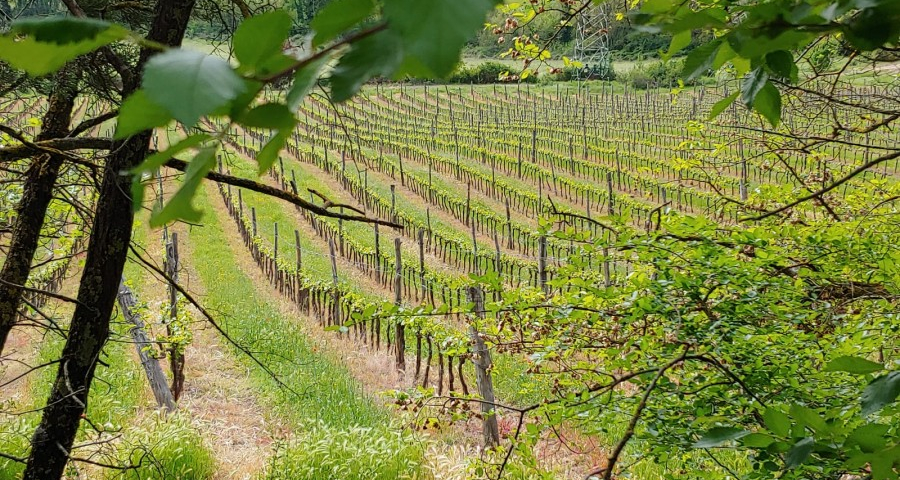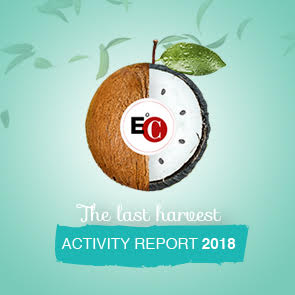The exile and the promise/27 – The temple is too small to contain the Love and waters of wisdom
by Luigino Bruni
published in Avvenire on 12/05/2019
«Alyosha stood, gazed, and suddenly threw himself down on the earth. He did not know why he embraced it. He could not have told why he longed so irresistibly to kiss it, to kiss it all. But he kissed it weeping, sobbing, and watering it with his tears, and vowed passionately to love it, to love it for ever and ever... Within three days he left the monastery in accordance with the words of his elder, who had bidden him “sojourn in the world»
Fëdor Dostoevskij, The Brothers Karamazov - Cana of Galilee
The page with the passage recounting the sacred place surrounded by water that irrigates the earth is one of the greatest pages and passages by Ezekiel and in the Bible. It contains the image of an authentically lay faith where the temple of God becomes the entire earth itself.
Water is one of the great symbols in the Bible. It is the alpha and the omega. The Pishon, the Tigris, the Nile, the Jordan, the Jabbok, Noah, Abraham, Hagar, Rachel, Moses, Mara, the Baptist, the Samaritan woman, the Golgotha. Rivers, wells, women. Water and life, water is life. Always and everywhere, especially on those semi-arid regions of the Near East, or in the withered and desertified lands of the heirs of Adam and Cain.
Sometimes in great literary works – and the Bible is one of them – you find a page which on its own says it all. These are different pages, summarizing the entire message of the book and all real and beautiful things that could be said on the subject. A page that, when reading it, gives you a fullness that satiates you completely. We can, we should read the entire book of Ezekiel, and then those of the other prophets, and all the Sapiential Books, all the way up to the Gospels and Paul, and maybe some texts of other spiritual traditions as well. But if at the end of this enterprise, we should want to say what we have understood about religion, about the spirit, about worship and the temple, we might never find anything better than the image offered by Ezekiel, of the new temple immersed in water, flowing from it to irrigate the earth: «The man brought me back to the entrance to the temple, and I saw water coming out from under the threshold of the temple toward the east... The water was coming down from under the south side of the temple, south of the altar. He then brought me out through the north gate and led me around the outside to the outer gate facing east, and the water was trickling from the south side» (Ezekiel 47,1-2).
The water grows right in front of Ezekiel while he, in the company of his surveyor guide-angel, watches it in wonder, a bit frightened: «As the man went eastward with a measuring line in his hand, he measured off a thousand cubits and then led me through water that was ankle-deep. He measured off another thousand cubits and led me through water that was knee-deep. He measured off another thousand and led me through water that was up to the waist. He measured off another thousand, but now it was a river that I could not cross» (Ez 47,3-5). After the highly meticulous descriptions of the temple, worship and offerings in the previous chapters, the prophet takes the floor first-hand and leaves us with a fresco of uncommon beauty. We are right there with him in the river stream, feeling the water grow from ankle-deep to waist-high and up. Ezekiel is in his causeway together with an angel. This time man and angel do not fight, there is no sciatic nerve injury. Only the blessing of an eternal message about the soul and spirit, about the temple and life, remains.
The vision continues: «When I arrived there, I saw a great number of trees on each side of the river. He said to me, “This water flows toward the eastern region and goes down into the Arabah, where it enters the Dead Sea. When it empties into the sea, the salty water there becomes fresh. Swarms of living creatures will live wherever the river flows. There will be large numbers of fish, because this water flows there and makes the salt water fresh; so where the river flows everything will live"» (Ez 47,6-9). The angel shows Ezekiel the landscape. Where there was only desert and aridity a great number of trees have now grown: «Their leaves will not wither, nor will their fruit fail. Every month they will bear fruit, because the water from the sanctuary flows to them. Their fruit will serve for food and their leaves for healing» (Ez 47,12). And the Dead Sea, a region which was considered cursed and sterile in ancient tradition, comes back to life, the salty waters are reborn fresh, and become populated with an infinity and variety of fish, like in the Mediterranean Sea («The Great Sea»: Ez 47,10). Water brings fertility and restoration, and above all it brings life. And so Ezekiel, after having offered us a few chapters with the mighty image of the wind and breath of the spirit resurrecting dried up bones, now has us relive the same experience with the water that gushes from the temple and floods the earth. Water and spirit, water is spirit.
The Bible is an immense and infinite ode to life. Everything in it only and ever speaks of life. It speaks of it in many ways and with many images, but in the culture and context of that passage the water sings of life in a new and very powerful way. Those people, heirs to the wandering Aramean, inhabitants of mobile tents, carry the search for water to live in their genetic code. They have seen it arrive for millennia to once again give life to what seemed dead and would actually be dead if it hadn’t arrived. They had seen the desert bloom in thousand colours after the spring rains, and it was in that resurrection that the most beautiful prayers were born, blossoming in the most poetic hymns. If we really wanted to discern something in this vision of the fountain-temple, we should read it while in the desert of Sur next to Hagar, or in the desert with Moses and the people barely whispering from thirst; feel the thirst in our own flesh and then experience the water arriving to save us. Water is the poor cousin of spirit: utile et humile et pretiosa et casta.
The great fresco of the waters and life culminates in man and his work: «Fishermen will stand along the shore; from En Gedi to En Eglaim there will be places for spreading nets» (Ez 47,10). Without men and women who work, the miracle of life is not complete. The vision of the temple began with the doors of the temple, then the altar, the offerings, the norms for the clergymen, the kitchens. Hence, water, life, fertility, the desert in bloom. But at the peak we find man, and then work. This is the essence of biblical humanism, this is Adam’s song, placing, however, workers and fishermen casting their nets, as the pinnacle of a cosmic manifestation of God. A few centuries later, other fishermen would bring the water of the spirit all over the world, recognizing in that voice the voice of life when it called out to them while working, because in their work they remained connected to the same source.
The fountain-temple, immersed in the waters creating a river flooding, fertilizing and enlivening the world, is one of the most beautiful pages in the Bible and among Ezekiel’s most prophetic ones. For it speaks of both past and future together: bereshit and eskaton. The water is found in the first chapter of the first book (Genesis), and in the last chapter of the last book (Revelation). In Ezekiel’s teachings this water contains one of the most powerful religious, theological and social messages in biblical humanism. The temple can be a gushing spring of life-giving water, provided that water does not remain locked up and jealously guarded within the temple. Only if it runs free from there to flood the world. The water of the temple is not destined for internal consumption within the temple. That water was not generated for the purification needs of religious worship. No: that water is born within, but runs on the outside. It is secular water, civil, centuries-old. Ezekiel minister of Jerusalem believes that the temple is the place for the presence of the glory of Yahweh on earth. But Ezekiel the prophet knows and proclaims that, that presence is not there to be consumed in the worship of its faithful, for it was generated to be donated to those who find themselves outside of the temple. "The source is not for me", the beautiful expression of Bernadette of Lourdes is a prophetic motto, universal in its relationship between the temple and the spirit. Water comes to fertilize the earth. It is not given freely from the Heavens to wash the gutters from the blood of the offerings by the foot of the temple altar. Religions and spiritual communities can continue to generate water of life and quench the thirst of the people if they overcome, with chastity, the constant temptation to drink the water that comes from it. Ezekiel, who has this vision after the temple is destroyed by Nebuchadnezzar, perceives that there will be a new temple once more, after the exile faith and temple could not stay the same as before – all mayor crises change the relationship between faith and worship. Having learnt, in their immense sorrow and pain that their God remained real despite defeat, that faith was possible even without a holy place because God’s place is the whole world, had forever changed religion and worship. The temple with the great waters is hence a great spiritual heritage of Ezekiel, a message originating from the land of exile of Babylon which spans the whole scripture. It is, for example, found in the book of Sirach, which returns to Ezekiel’s image of the fountain-temple and applies it to wisdom: «I also issued forth like a channel from a river and like a water trench into a garden, I said: "I will irrigate my plantation, and I will saturate my garden plot". And behold the channel became for me a river, and my river became a lake» (Book of Ben Sira 24,30-31). The temple is too small to contain the Love and waters of wisdom. And, in the end, Ezekiel comes back to the conclusion in Revelation, in another masterpiece image, as the pinnacle of more than half a millennium worth of prophecy that had opened the temple wide to make it coincide with the whole world: «And he showed me a pure river of water of life, bright as crystal, coming forth out of the throne of God and of the Lamb. In the midst of its street and of the river, from here and from there, was a tree of life producing twelve fruits, according to one month each yielding its fruit; and the leaves of the tree were for healing of the nations» (Rev 22,1-2).
Here the water does not gush from under the temple, but from the "throne of God and of the Lamb". In the final epiphany of the spirit the temple is gone. The temple has disappeared from the landscape of Jerusalem, as we read in a few verses before in another paradoxical and wondrous passage: «I did not see a temple in the city, because the Lord God Almighty and the Lamb are its temple» (Rev, 21, 22). Like the Law, the temple too is a pedagogue, which one day will have to disappear to make way for the direct encounter with the water of life. In this new world the "tree of life" no longer finds itself in the Garden of Eden, but grows in the middle of the city in the middle of its street. A marvellous phrase. The street shall be the new name of the temple. This is the great song of biblical laity: sister street, brother office, sister factory, brother job. Sister water. When will we have all of this in full? «Yes, I am coming soon!» (Rev 22, 20).
Download pdf article in pdf (327 KB)








